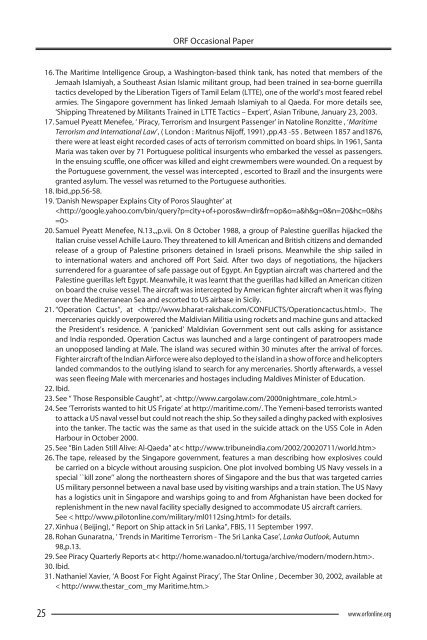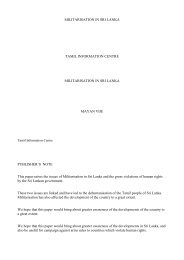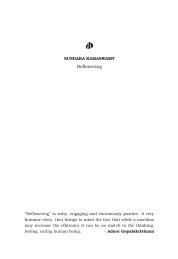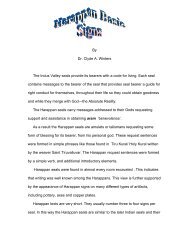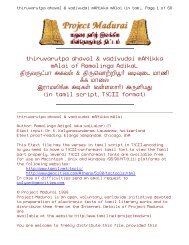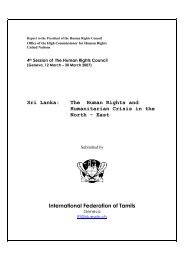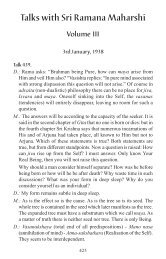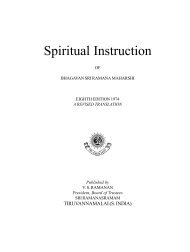Asymmetric Warfare And Low Intensity Maritime Operations
Asymmetric Warfare And Low Intensity Maritime Operations
Asymmetric Warfare And Low Intensity Maritime Operations
- No tags were found...
You also want an ePaper? Increase the reach of your titles
YUMPU automatically turns print PDFs into web optimized ePapers that Google loves.
ORF Occasional Paper<strong>Asymmetric</strong> <strong>Warfare</strong> <strong>And</strong> LIMO: Challenges For Indian Navy16. The <strong>Maritime</strong> Intelligence Group, a Washington-based think tank, has noted that members of theJemaah Islamiyah, a Southeast Asian Islamic militant group, had been trained in sea-borne guerrillatactics developed by the Liberation Tigers of Tamil Eelam (LTTE), one of the world’s most feared rebelarmies. The Singapore government has linked Jemaah Islamiyah to al Qaeda. For more details see,‘Shipping Threatened by Militants Trained in LTTE Tactics – Expert’, Asian Tribune, January 23, 2003.17. Samuel Pyeatt Menefee, ‘ Piracy, Terrorism and Insurgent Passenger’ in Natoline Ronzitte , ‘<strong>Maritime</strong>Terrorism and International Law’, ( London : Maritnus Nijoff, 1991) ,pp.43 -55 . Between 1857 and1876,there were at least eight recorded cases of acts of terrorism committed on board ships. In 1961, SantaMaria was taken over by 71 Portuguese political insurgents who embarked the vessel as passengers.In the ensuing scuffle, one officer was killed and eight crewmembers were wounded. On a request bythe Portuguese government, the vessel was intercepted , escorted to Brazil and the insurgents weregranted asylum. The vessel was returned to the Portuguese authorities.18. Ibid.,pp.56-58.19. ‘Danish Newspaper Explains City of Poros Slaughter’ at20. Samuel Pyeatt Menefee, N.13.,,p.vii. On 8 October 1988, a group of Palestine guerillas hijacked theItalian cruise vessel Achille Lauro. They threatened to kill American and British citizens and demandedrelease of a group of Palestine prisoners detained in Israeli prisons. Meanwhile the ship sailed into international waters and anchored off Port Said. After two days of negotiations, the hijackerssurrendered for a guarantee of safe passage out of Egypt. An Egyptian aircraft was chartered and thePalestine guerillas left Egypt. Meanwhile, it was learnt that the guerillas had killed an American citizenon board the cruise vessel. The aircraft was intercepted by American fighter aircraft when it was flyingover the Mediterranean Sea and escorted to US airbase in Sicily.21. “Operation Cactus”, at . Themercenaries quickly overpowered the Maldivian Militia using rockets and machine guns and attackedthe President’s residence. A ‘panicked’ Maldivian Government sent out calls asking for assistanceand India responded. Operation Cactus was launched and a large contingent of paratroopers madean unopposed landing at Male. The island was secured within 30 minutes after the arrival of forces.Fighter aircraft of the Indian Airforce were also deployed to the island in a show of force and helicopterslanded commandos to the outlying island to search for any mercenaries. Shortly afterwards, a vesselwas seen fleeing Male with mercenaries and hostages including Maldives Minister of Education.22. Ibid.23. See “ Those Responsible Caught”, at 24. See ‘Terrorists wanted to hit US Frigate’ at http://maritime.com/. The Yemeni-based terrorists wantedto attack a US naval vessel but could not reach the ship. So they sailed a dinghy packed with explosivesinto the tanker. The tactic was the same as that used in the suicide attack on the USS Cole in AdenHarbour in October 2000.25. See “Bin Laden Still Alive: Al-Qaeda” at< http://www.tribuneindia.com/2002/20020711/world.htm>26. The tape, released by the Singapore government, features a man describing how explosives couldbe carried on a bicycle without arousing suspicion. One plot involved bombing US Navy vessels in aspecial ``kill zone’’ along the northeastern shores of Singapore and the bus that was targeted carriesUS military personnel between a naval base used by visiting warships and a train station. The US Navyhas a logistics unit in Singapore and warships going to and from Afghanistan have been docked forreplenishment in the new naval facility specially designed to accommodate US aircraft carriers.See < http://www.pilotonline.com/military/ml0112sing.html> for details.27. Xinhua ( Beijing), “ Report on Ship attack in Sri Lanka”, FBIS, 11 September 1997.28. Rohan Gunaratna, ‘ Trends in <strong>Maritime</strong> Terrorism - The Sri Lanka Case’, Lanka Outlook, Autumn98,p.13.29. See Piracy Quarterly Reports at< http://home.wanadoo.nl/tortuga/archive/modern/modern.htm>.30. Ibid.31. Nathaniel Xavier, ‘A Boost For Fight Against Piracy’, The Star Online , December 30, 2002, available at< http://www.thestar_com_my <strong>Maritime</strong>.htm.>32. Ibid. The fence (9,000 volt) can be installed and dismantled by the crew at any time. When tamperedwith, it will trigger an alarm, activate floodlights and a very loud siren. According to the IMB, thegadget has been tested at various sea conditions including force 7 seas; with salt waves splashingover it and apparently, the system keeps working with no false alarms and side effects.33. See ‘ Terrorism Probe Extends To Shipping’, American <strong>Maritime</strong> Officer’ at34. See ‘Murky Flag-Of-Convenience Ship Registry System Could Hamper Effort To UncoverTerrorist Assets’ at 35. See Knight Rider, ‘ US Ports Represent Weakness In Nation’s Defence Analyses Show’ at< http://www.military.com>36. Ibid.37. See ‘ What are FOCs’, at < http://www.itf.org.uk/seafarer/foc/Body_foc..html.> A FOC ship is a vesselthat flies flag of a country other than the country of ownership. It enables owners to avoid highregistration fees, taxes and employ cheap labor under sub-standard conditions. In some cases, privatecompanies rather than the administration may run the national ship registry. For instance, a US privatecompany runs Liberia’s registry. In some cases the registration of vessels can even be done onlineclearly indicating absence of any regulations. Among the 30 FOC registries, Bahamas, Liberia andPanama are known to possess large merchant fleets accounting for about half the total percentageof global merchant shipping tonnage. There are several benefits for terrorists in owning ships withFOC registry. It is the safest way to smuggle personnel and equipment and perhaps even biological ornuclear weapons into any port.38. ‘Killing Of Sea Bird Not A Big Blow to LTTE Shipping <strong>Operations</strong>, The Sunday Times, February 1996.The LTTE ships are difficult to keep track of as they keep changing names and registry. Lloyds, lists11 merchant ships belonging to some Asian front companies but in fact are managed by the elusiveKumaran Pathmanathan (a businessman who is wanted in Colombo for half a million dollars).39. Rohan Gunaratna, ‘ Illicit transfer of Conventional Weapons: The Role of State and Non-state Actors inSouth Asia’, in ed. Jayantha Dhanapala, Ambasssador Mitsuro Donowaki, Swadesh Rana, Lora LumpeSmall Arms Control, Old Weapons, New Issues (Alderrshot: Ashgate, 1999), p.266.40. See’ Arms seizures Backfires’ at 2120GMT,020108 < http://www.stratfor.com>.41. See ‘Ripples from Oil Spill’, December 02, 2002 at < http://www.NewJersey.com>42. John Mintz, ‘15 Freighters Believed to Be Linked To Al Qaeda: US Fears Terrorists at Sea; TrackingShips Is Difficult’, December 31, 2002, available at < http:///www. washingtonpost.com.> . Also see‘TongaTargetted as Home of bin Laden’s Ships’ at < http://www.smh.com.au.>. Tonga’s role in FOCgoes back to 2000 and the arrival in Nuku’alofa of Peli Papadopoulos, who said he represented AxionServices Ltd in Piraeus, Greece. He persuaded authorities to allow him to run Tonga InternationalRegistry of Ships (TIRS) out of Athens. In January 2002 Israeli commandos seized Karine A, a Tonganflagged ship, in the Red Sea and found it was carrying 50 tonnes of mainly Iranian weapons allegedlymeant to be given to the Palestinians. Tongan Police Minister Clive Edwards said then that policewere investigating what happened. In June 2002 a Tongan government statement said TIRS was tobe closed down. “The TIRS had also not lived up to commercial expectations,” chairman of a cabinetcommittee, Noble Fielakepa said in a statement. “International terrorism and an increase in peoplesmuggling and asylum seekers were clearly key factors. Even our own region has felt the impact ofthese problems.” In October, Croatian police seized the Tongan registered ship Boka Star that theyclaimed was smuggling military explosives to Iraq.43. Ibid.44. Ibid.45. See ‘ What are FOCs’, at < http://www.itf.org.uk/seafarer/foc/Body_foc..html.>46. Ibid.47. See ‘IMB Calls For Clamp-Down on Fake <strong>Maritime</strong> Documents’ at .48. Ibid.49. Ibid.25www.orfonline.orgwww.orfonline.org 26


